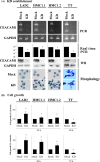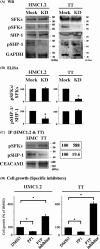CEACAM1 long isoform has opposite effects on the growth of human mastocytosis and medullary thyroid carcinoma cells
- PMID: 28332308
- PMCID: PMC5387134
- DOI: 10.1002/cam4.1050
CEACAM1 long isoform has opposite effects on the growth of human mastocytosis and medullary thyroid carcinoma cells
Abstract
Carcinoembryonic antigen-related cell adhesion molecule 1 (CEACAM1) is expressed in a number of tumor cell types. The immunoreceptor tyrosine-based inhibitory motif (ITIM)-containing isoforms of this molecule which possess a long cytoplasmic tail (CEACAM1-L) generally play inhibitory roles in cell function by interacting with Src homology 2 domain-containing tyrosine phosphatase (SHP)-1 and/or SHP-2. Src family kinases (SFKs) are also known to bind to and phosphorylate CEACAM1-L isoforms. Here, we report that CEACAM1 was uniquely expressed at high levels in both human neoplastic mast cells (mastocytosis) and medullary thyroid carcinoma cell (MTC) lines, when compared with their expression in nonneoplastic mast cells or nonneoplastic C cells. This expression was mainly derived from CEACAM1-L isoforms based upon assessment of CEACAM1 mRNA expression. CEACAM1 knockdown upregulated cell growth of HMC1.2 cells harboring KIT mutations detected in clinical mastocytosis, whereas downregulated the growth of TT cells harboring RET mutations detected in clinical MTCs. Immunoblotting, ELISA and immunoprecipitaion analysis showed that activated SHP-1 is preferentially associated with CEACAM1 in HMC1.2 cells harboring KIT mutations, whereas Src family kinases (SFKs) are preferentially associated with CEACAM1 in TT cells harboring RET mutations. These studies suggest that the dominantly interacting proteins SHP1 or SFK determine whether CEACAM1-L displays a positive or negative role in tumor cells.
Keywords: CEACAM1; SHP-1; Src family kinases; mast cell; medullary thyroid carcinoma.
© 2017 The Authors. Cancer Medicine published by John Wiley & Sons Ltd.
Figures




References
-
- Gray‐Owen, S. D. , and Blumberg R. S.. 2006. CEACAM1: contact‐dependent control of immunity. Nat. Rev. Immunol. 6:433–446. - PubMed
-
- Watt, S. M. , Teixeira A. M., Zhou G. Q., et al. 2001. Homophilic adhesion of human CEACAM1 involves N‐terminal domain interactions: structural analysis of the binding site. Blood 98:1469–1479. - PubMed
-
- Huber, M. , Izzi L., Grondin P., et al. 1999. The carboxyl‐terminal region of biliary glycoprotein controls its tyrosine phosphorylation and association with protein‐tyrosine phosphatases SHP‐1 and SHP‐2 in epithelial cells. J. Biol. Chem. 274:335–344. - PubMed
MeSH terms
Substances
Supplementary concepts
Grants and funding
LinkOut - more resources
Full Text Sources
Other Literature Sources
Medical
Miscellaneous

